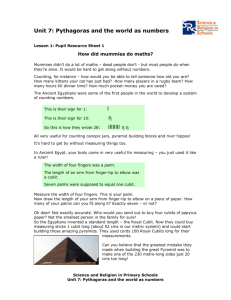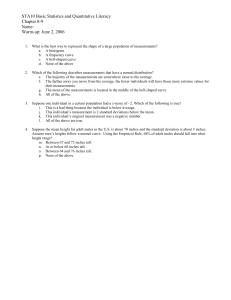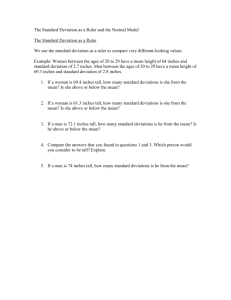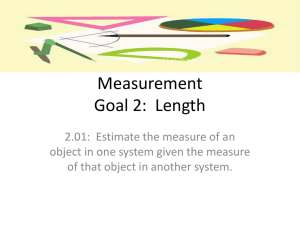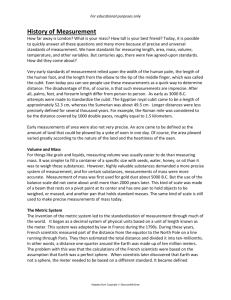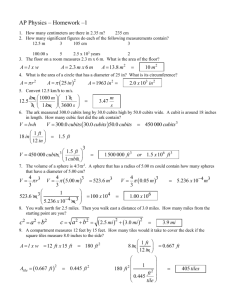Grade 6 Math Circles Measurement Systems How Much?
advertisement
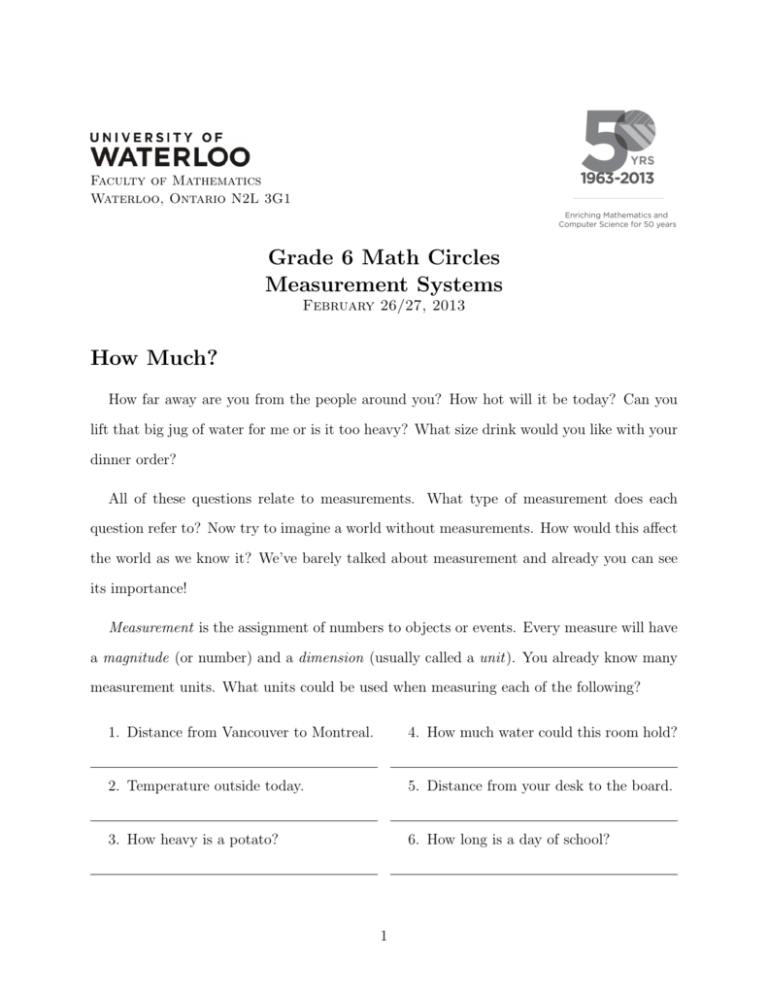
Faculty of Mathematics Waterloo, Ontario N2L 3G1 Grade 6 Math Circles Measurement Systems February 26/27, 2013 How Much? How far away are you from the people around you? How hot will it be today? Can you lift that big jug of water for me or is it too heavy? What size drink would you like with your dinner order? All of these questions relate to measurements. What type of measurement does each question refer to? Now try to imagine a world without measurements. How would this affect the world as we know it? We’ve barely talked about measurement and already you can see its importance! Measurement is the assignment of numbers to objects or events. Every measure will have a magnitude (or number) and a dimension (usually called a unit). You already know many measurement units. What units could be used when measuring each of the following? 1. Distance from Vancouver to Montreal. 4. How much water could this room hold? 2. Temperature outside today. 5. Distance from your desk to the board. 3. How heavy is a potato? 6. How long is a day of school? 1 It’s very important when measuring to include both a magnitude and dimension. If you say the length of your pencil is 25, it doesn’t help. It could be 25cm, 25m, 25mm, or 25 pink and purple elephants! (How much is that?) Ancient Tools For the questions above everyone probably wrote down similar units: metres, grams, degrees Celsius, and so on. These are all metric units (more on this later). However, metric units weren’t used until the late 1700s. So what units were used before metric? The first known units of measurement were for length, created over 4000 years ago. The ancient Mesopotamians and Egyptians used a measurement called the cubit. It is the distance from the elbow to the end tip of the middle finger. Note how the cubit is the length of part of your body. This was convenient since carrying a measuring stick could get pretty annoying. Find a partner and measure each other’s height in cubits. How tall are you? How tall is your partner? Do you see any problem with using cubits? What if you wanted to trade 15 cubits of lumber for 5 cubits of fabric? What would you need to consider? Some other lengths these people used were: • the hand : base of the palm to the tip of the middle finger • the palm: the width of the palm • the digit: the width of the middle finger When it came to mass, a small unit was a grain. It was literally the mass of one grain of wheat or barley! This was more common for weighing gold and silver (if you were wealthy). A stone (again, literally a stone) was used for more common objects in markets. Many ancient civilizations used these measurements. 2 Eventually, the measurements were standardized, where the units are set to a specific size for everyone. Usually, the standard size would be based off royalty, so the standard cubit would be the king’s cubit. For length, sticks with markings would be used to measure the cubit (that’s why we use rulers today for measuring). Larger and smaller units could also be standardized too based off the known units. A hand was considered half a cubit, a palm onesixth of a cubit, and a digit one twenty-fourth of a cubit. Now more accurate measurements could be taken. Today, every commonly used measuring system is standardized. Measurement Systems One issue that arose with even standardized units, such as the cubit, was that every country had its own standardized measuring units. One standard cubit in Egypt would not be the same as one in Babylon. Nowadays, this problem has been eliminated because of measurement systems; units that are related and cannot change. Every country uses standard units that are universal; one metre in Canada is the same as one metre in China. There are two major measurement systems used in the world today. The Metric System In Canada and in almost every country in the world, the Metric System is used. This system includes metres, grams, litres, and degrees Celsius. You have had the most experience with this system in school and in your lives. The nicest part of the metric system is that it runs on a base 10 system. Most conversions from one metric unit to another, change by 10 or some multiple of 10. There are 1000 millilitres to 1 litre. There are 100 centimetres to 1 metre. 1000 kilograms to 1 tonne. 100 degrees between freezing and boiling water. Ones and zeros are nice to work with when converting units. As well naming follows a pattern; there are milli metres, milli litres, and milli grams which are 1000 times smaller than their base unit. 3 The Imperial System The U.S.A. and a few more countries officially use the Imperial System of measurement. Many people outside these places, including Canada, use Imperial measurements for certain tasks. You’ve probably used Imperial units before. How tall are you? How much do you weigh? Many people know their height in feet and inches rather than centimetres, and weight in pounds rather than kilograms. Many construction tools also use inches rather than centimetres. However, since this system is relatively new for most people, we will spend most of the time looking at Imperial Units and comparing them to metric units. Length and Distance Take out your ruler. Many (but not all) will have centimetres listed on one edge and on the other edge will be inches. Students who have a 30cm ruler will notice that it will have 12 inches on it. There are 12 inches in one foot. So your 30cm ruler is also one foot long. (Actually there are 30.48cm in one foot, so usually rulers are a bit longer than 30cm). Just like in the metric system, there are short form ways to write units. Feet are denoted by ’ or ft, and inches shown by ” or in. 12 inches = 1 foot is the same as saying 12” = 1’ or 12in = 1ft. Convert the following lengths to inches. 5ft = 3’7” = 6’11” = Convert the following lengths to feet and inches. 96in = 17” = 71” = For measuring lengths smaller than one inch or that fall between inches, fractions of an inch are used, as opposed to decimals in the metric system. The ticks on a ruler mark these 4 1 1 (or sometimes ) of an inch apart. The tick marks 8 16 will also have different lengths. The longest lengths are inches and will be marked with a 1 number. The inch lines are next longest, and so on to the shortest lines which represent 2 eighths (or sixteenths) of an inch. smaller units. Often the ticks are 1 0 1/4 1/2 3/8 1/8 1/16 (on some rulers) 0 inches 5/8 3/4 7/8 1 inch 2 1 and 1/2 Note that this diagram is ’zoomed in’ on a ruler so this is not actually 2 inches long. As you can see, knowing fractions is very important when dealing with smaller lengths. 1 Here’s an example of written partial inches: Mr. Auckland’s height is 6’1 ” 2 For lengths that are longer, there are yards and miles. There are 3 feet in one yard (or yd) and 5280 feet in one mile (or mi). About how many centimetres are in one yard? How many yards are in one mile? See the chart at the end of the handout for a full summary of useful conversion rates. Temperature In Celsius (metric), water freezes at 0°C and boils at 100°C. The Imperial unit for temperature is degrees Fahrenheit (short form °F). In Fahrenheit, water freezes at 32°F and boils at 212°F. So there are 180°F between freezing and boiling point of water. What else do you know that has 180° in it? There is a simple formula to convert from Celsius and Fahrenheit. Take your temperature in Celsius multiply by 9 and divide by 5 then add 32 to get the temperature in Fahrenheit. 5 We can write this as F = (C × 9 ÷ 5) + 32 where F is temperature in Fahrenheit and C is temperature in Celsius. We have a similar formula if given a temperature in Fahrenheit and we want to convert to Celsius: C = (F − 32) × 5 ÷ 9. Convert each temperature to the given unit. 15°C = °F 50°F = °C 30°C = °F 77°F = °C Mass In the Imperial System, the most common units of mass are ounces, pounds and tons. Ounces are the smallest unit with short form oz, and 1oz equals 28.35g. Small chocolate bars you get on Halloween and a slice of bread are items that weigh about 1oz. One pound (short form lbs) equals 16oz or about 453.6g. A package of butter, a football, a shoe, or 3 bananas each weigh about 1 pound. A 2L bottle of pop and a bag of sugar weigh about 5lbs. The average newborn baby will weigh between 6lbs and 9lbs. When you were born you were likely weighed in terms of pounds and ounces. One ton equals 2000lbs or about 907.18kg (don’t confuse this with the metric tonne=1000kg!). A small car can weigh 1 to 2 tons and an adult elephant can weigh between 3 to 6 tons. Volume There are many different units used to measure volume, many of which depend on whether the object is a solid or a fluid. We will just focus on some of the basics. The cubic inch (in3 or cu in), cubic foot (ft3 or cu ft) and cubic yard (yd3 or cu yd) are all units of volume. Similar to cm3 or m3 , these units represent the amount of volume taken up by a cube with side lengths of 1 inch, foot or yard. One gallon (short form gal), is equal to 231 cu in or about 3785mL. The gallon is divided into quarts, pints, and cups. There are 4 quarts (short form qt) in a gallon (think quarters!), and 1qt equals about 1L. 6 1 the volume of a gallon. Fresh berries are often sold in pints or quarts (those 8 little green baskets). A pint is 1 the size of a gallon. Cups are often used for measuring ingredients 16 while cooking or baking. So 1gal = 4qt = 8 pints = 16 cups = 231in3 . Finally, a cup is There are many other units for volume but they can get quite complex so we will skip over them. See the chart at the end of the lesson for a summary of volume. Now return to the questions on the first page and add in what Imperial units you would use to measure each object or event (skip question 6). What Else Can We Measure? Some objects or events don’t fall under traditional metric or imperial systems. Time This is one of the few measurements standard throughout the world. A day is divided into 24 hours of 60 minutes with each minute consisting of 60 seconds. However, years are not always standard. Chinese New Year takes place in January or February every year so not every Chinese year is 365 days long. Even a standard year has 366 days every 4 years (a leap year). Despite these differences, time is generally standard anywhere in the world. Light-year When measuring distances in space, using kilometres can get pretty annoying; distances between stars can be trillions of kilometres away from each other and that’s a lot of digits to write! Instead, astronomers use light-years to measure distance. A light-year is the distance light travels in one year. Let’s calculate how many kilometres are in 1 light-year. The speed of light is 299 792 458 metres per second (or m/s) or 299 792.458km/s. This seems like a big number, but how big 7 is it? The circumference of the Earth is about 40 000km and we know that the speed of light is about 300 000km/s. So 300 000 ÷ 40 000 = 7.5. So if light could travel in a circle, it 1 would make it around the world 7 times in just one second; that’s fast! 2 To calculate the distance light travels in a year we need to know how many seconds are in a year. We know there are 60 seconds in a minute and 60 minutes in an hour, then there are 60s/min × 60min/h = 3600 seconds in an hour. Now there are 24 hours in a day and 365.25 days a year (.25 accounts for leap years), so 3600s/h × 24h/day × 365.25days/year = 31 557 600 seconds per year. So light travels 31 557 600 × 299792.458 = 9 460 730 472 581km in one year, which is the length of 1 light-year! Nearly 10 trillion kilometres; that’s far! Comparing Objects or Events The last method of measuring we will study doesn’t have standard units, which may seem odd considering all the issues we saw with cubits! Most of the above methods require some tool to make an accurate measurement (a ruler, scale, even your arm for a cubit!). However we can compare traits of different objects. We can say a boulder is heavier than a loaf of bread, a large cup of hot chocolate has more volume than a small cup, and a bicycle is slower than a train. Despite not having units, we know what is being compared. It doesn’t make sense for the boulder example above to be measuring height since the word heavier is used (we know this means mass). As well it’s easy to visualize both a boulder and a loaf of bread, which is enough to decide whether a loaf of bread or a boulder is heavier. We didn’t need to take a scale to find the mass of both objects. We can also create our own ’units’ when comparing objects. ’The pond at my cottage is the size of 5 swimming pools!’ is a much easier comparison to understand since people know what a swimming pool looks like, and can visualize 5 of them together. This is much nicer to understand than ’the pond at my cottage holds 100 000 litres of water.’ What does 100 000L even look like? Can you understand the difference in these comparisons? 8 Some objects frequently used for comparing measurements include: an Olympic sized pool, the Titanic, the Pyramids, the Eiffel Tower (or other famous buildings), size of a potato (or other foods), a race car, and many other commonly known objects. Note that these comparisons don’t need to be exact; you can estimate! Now that you know many different ways to measure objects and events, try using as many methods as possible since practice will help you get better at using and converting between units! The ≈ symbol means approximately, meaning some decimals were rounded. 1in = 2.54cm 1cm ≈ .394in 1yd = 91.44cm 1m ≈ 1.094yd or 3.281ft 1mi ≈ 1.609km 1km ≈ .621mi 5280ft = 1mi 3ft = 1yd Table 1: Length Conversions Also there are about 5mi for every 8km. This is great for approximating longer distances. 1gal = 231 cu in 1gal = 16 cups 1gal = 4qt 1gal = 8pt 1gal ≈ 3785mL 1qt ≈ 946mL Table 2: Volume Conversions This ruler is the proper size and can be used when answering some problems using inches. 0 1 2 3 9 4 5 6 Problems 1. Take 3 different items around you (a desk, chair, your pencil) and measure their length and/or height using: (a) cubits (c) palms (e) inches (b) hands (d) digits (f) feet 2. Using a ruler, measure the length of your cubit. If you were the king or queen of an ancient country (so your cubit would be standard), how many cubits long would a piece of lumber be if it was 10 metres long? If there is a 27 cubit tall statue of you (you are the ruler remember!) how tall is your statue in metres? 3. Measure each item twice; once in terms of Metric units and again using Imperial units. Be as precise as you can. (a) Your pencil or pen. (c) Your height (find a partner to help). (b) Your thumb. (d) The length and width of this paper. 4. Convert each measurement to the given unit. 1 (a) 27 in to 4 ’ (c) 12 320yd to mi ” form (b) 51’ to yd (d) 3mi to feet 5. Convert each length from Metric form to the given Imperial units. (a) 11m to ft (d) 17.78cm to in (b) 56km to mi (approximate) (e) 124km to mi (c) 320cm to yd (f) 1 609 344mm to mi 10 6. Convert each length from Imperial form to the given Metric units. (a) 100yd to cm then m (d) 5’2” to cm (b) 875mi to km (approximate) (e) 177mi to km 1 (c) 15 in to cm 2 (f) 35mi to m 7. Fill in the blanks with <(less than), >(greater than), or =, to make each statement true. (a) 16yd 16m (c) 2” (b) 15mi 20km (d) 2.54m 5cm 100in 8. Convert each temperature into °F or °C. (a) 95°C (c) 25°C (b) 68°F (d) 104°F 9. Convert each measurement to the given units. 1 (a) 3 lbs to oz. 2 (d) 10 tons to tonnes (round) (b) 5 tons to kg (e) 510.3g to oz (c) 15lbs to g (f) 35 273.6oz to tonnes (round) 11 10. What is the volume of each shape? Convert your answer to the given unit. (a) Convert cubic inches to gallons. Also state the volume in quarts, pints and cups. 7" 6" 11" (b) Convert cubic feet to cubic yards. 3 ft 3 ft 18 ft 11. The star closest to earth (after the Sun) is Proxima Centauri. It is about 4.24 lightyears from Earth. How many kilometres is that? If your car could fly in space, at a speed of 100km/h (highway speed) how long would it take to get to the star? The average passenger jet travels at 800km/h. How long would it take to get to Proxima Centauri at this speed? The Space Shuttle could travel at over 25 000km/h. How long would it take to reach the star at that speed? 12 12. For the following measurements, find the number of objects needed to make each comparison true. (a) The CN Tower is 553m tall. If the average unsharpened pencil is 19cm tall, how many pencils stacked end to end would it take to reach the top of the CN Tower? (b) The average grade 6 student weighs about 35kg. If a full grown male elephant weighs 7 tonnes, how many grade 6 students would it take to balance a see-saw with an elephant on one end? Would all the students in your grade at school weigh more than an elephant? (c) The Titanic was 269m long. The average school bus is 46ft long. How many buses stuck bumper to bumper in traffic, would it take to be the same length as the Titanic? (d) An elephant can get as tall as 4m. How many elephants would it take, stacked on top of one another, to be just taller than the CN Tower? The Titanic weighed approximately 48 650 tonnes. About how many stacks of elephants as tall as the CN Tower would it take to weigh the same as the Titanic? If all these elephants were stacked on top of one another, how tall would this stack be? 13. CHALLENGE: Review the process we used for finding the length of a light-year. Use similar ideas to find the distance (in km) of a light-minute (distance light travels in one minute), a light-hour (distance light travels in one hour) and a light-day (distance light travels in one day). Another unit used when measuring distances in space is the Astronomical Unit (AU). 1 AU is the distance between the Earth and the Sun. If light takes 8 minutes 19 seconds to travel 1 AU, how far away from the Sun is Earth (in km)? 13
